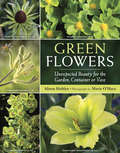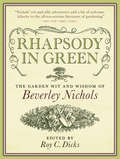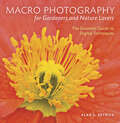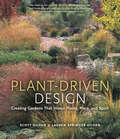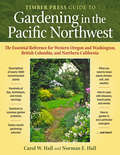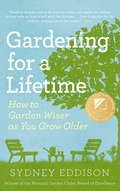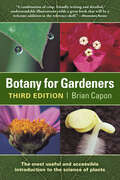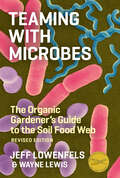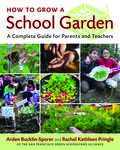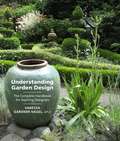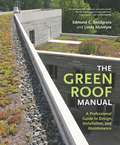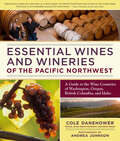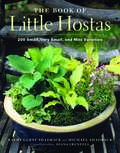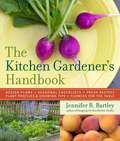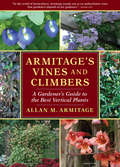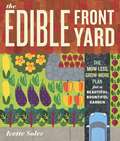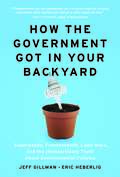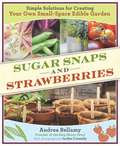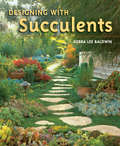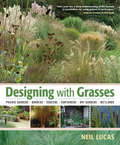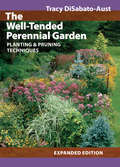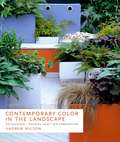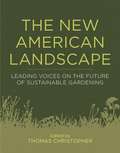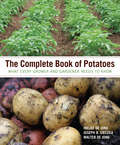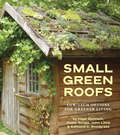- Table View
- List View
Green Flowers: Unexpected Beauty for the Garden, Container or Vase
by Alison Hoblyn Marie O'HaraGreen in the garden is at once the most common color of foliage and the rarest color found in flowers. Whether you're a home gardener looking for a jolt of freshness or a floral designer seeking inspiration, this charming collection of unexpected plants provides a palette of flowering greens for year-round display. Combining Marie O'Hara's sumptuous photography and Alison Hoblyn's evocative text, Green Flowers explores the history, botany, care, and cultivation of green-flowered plants. The hand-picked selection includes trees, grasses, vines and climbers, annuals, perennials, bulbs, wildflowers, exotics, orchids, edible plants, and water garden plants. The appeal of the selection is broad: Jack-in-the-pulpit provides curiosity; fritillaries and columbines lend quiet beauty; and green roses, hellebores, and irises are an excellent foil to their more colorful companions. Eighty-four plants are included in all. Complete tips on growing and arranging the plants are given for each entry, as well as an account of the interesting myths, history, and lore.
Rhapsody in Green: The Garden Wit and Wisdom of Beverley Nichols
by Beverley Nichols Roy C. DicksBeverley Nichols (1898–1983) was a prolific author, playwright, composer, and media personality. Though much of his work has been forgotten, his garden writing has stood the test of time. His amusing anecdotes, poetic contemplations, and penetrating observations speak to all gardeners—from houseplant killers to nursery professionals—and capture the joy, heartache, and hilarity of gardening.Rhapsody in Green speaks to the true spirit of Beverley Nichols. Compiled by Roy C. Dicks and drawn from fifteen of his best titles, these carefully selected passages offer a tantalizing taste of Nichols's humor, passion, and poetry. Designed for easy browsing and casual reference, it is organized by subject, including favorite plants, despised plants, and the secrets to successful gardening. Readers will also delight in William McLaren's original line drawings spread throughout the text. A must-have for Nichols fans, gardeners, and plant lovers.
Macro Photography for Gardeners and Nature Lovers: The Essential Guide to Digital Techniques
by Alan L. DetrickGardeners and nature lovers delight in taking pictures—especially close-ups of flowers, butterflies, and insects. And though advances in digital camera technology have made taking, storing, and sharing photos easier than ever, taking top-quality pictures requires familiarity with both digital technology and the general principles of photography. Macro Photography for Gardeners and Nature Lovers provides exactly the information that aspiring photographers—no matter their level of skill—need to take their photos to the next level. Clear and concise chapters cover the basics of macro (close-up) photography, explain the features of current digital single-lens reflex cameras, show the many ways images can be composed, and share tips on digital effects, storage, and manipulation of imagery. Throughout the text, helpful tips, definitions, exercises, and case studies serve to demystify digital photography. Each lesson is supported by examples of the author's stunning photography. Whether taking photos of flowers and insects, compiling a photographic record of your garden, or simply sharing beautiful images with friends and family, everyone can become accomplished photographers of the world's small-scale wonders.
Plant-Driven Design: Creating Gardens That Honor Plants, Place, and Spirit
by Scott Ogden Lauren Springer OgdenFor too long, garden design has given pride of place to architecture, artifice, and arbitrary principles. The results? Soulless landscapes where plants play subordinate roles.With passion and eloquence, Scott Ogden and Lauren Springer Ogden argue that only when plants are given the respect they deserve does a garden become emotionally resonant. Plant-Driven Design shows designers how to work more confidently with plants, and gives gardeners more confidence to design. The Ogdens boldly challenge design orthodoxy and current trends by examining how to marry plantsmanship and design without sacrificing one to the other.Supported by extensive lists of plants adapted to specific purposes and sites, Plant-Driven Design explores how plants interact with place. In addition, the authors' experience gardening and designing in a wide variety of climates gives their perspective a unique depth. In ideas, scope, and detail, this book both embraces and transcends regionality. By reclaiming gardens as a home to plants, this groundbreaking work will restore life-affirming vitality to garden design and profoundly affect how we understand and experience gardens.
The Timber Press Guide to Gardening in the Pacific Northwest: The Essential Reference For Western Oregon And Washington, British Columbia, And Northern California
by Carol W. Hall Norman E. HallTired of being lumped into the unwieldy category of a western garden? Frustrated by the lack of reliable, practical information about gardening in the Pacific Northwest? No longer! The Timber Press Guide to Gardening in the Pacific Northwest presents all the information a gardener—whether novice or expert—needs to keep their garden beautiful and thriving. With a combined 100 years of gardening experience in the Pacific Northwest, the authors clearly explain the unique challenges and joys of gardening in the region. By dividing the Pacific Northwest into seven subregions, they help readers to better understand the climatic and geographical factors that shape their gardens. This complete guide includes extensive profiles of plants that are ideally suited to the region, including perennials, ornamental grasses, bulbs, groundcovers, roses, shrubs, trees, and climbers. The month-by-month gardening calendar describes what weather patterns to expect, what's in bloom, and what garden tasks are best done in that month. With additional chapters detailing the most common gardening problems and recommendations for effective, nontoxic ways of dealing with them, this book is nothing short of essential.
Gardening for a Lifetime: How to Garden Wiser as You Grow Older
by Sydney EddisonFrom the winner of the National Garden Club's Award of Excellence Although the garden may beckon as strongly as ever, the tasks involved—pulling weeds, pushing wheelbarrows, digging holes, moving heavy pots—become increasingly difficult, or even impossible, with advancing age. But the idea of giving it up is unthinkable for most gardeners. So what’s the alternative? In Gardening for a Lifetime, Sydney Eddison draws on her own forty years of gardening to provide a practical and encouraging roadmap for scaling back while keeping up with the gardening activities that each gardener loves most. Like replacing demanding plants like delphiniums with sturdy, relatively carefree perennials like sedums, rudbeckias, and daylilies. Or taking the leap and hiring help—another pair of hands, even for a few hours a week, goes a long way toward getting a big job done. This new edition features an additional chapter describing how Sydney’s struggles with hip and back problems forced her to walk the walk. As a friend of hers says, “Last summer you wrote the book. Now, I’m happy to see that you’ve read it.” Gentle, personable, and practical, Gardening for a Lifetime will be welcomed by all gardeners looking to transform gardening from a list of daunting chores into the gratifying, joyful activity it was meant to be.
Botany for Gardeners: Third Edition (Science For Gardeners Ser.)
by Brian CaponA bestseller since its debut in 1990, this indispensable and handy reference has now been expanded and updated to include an appendix on plant taxonomy and a comprehensive index. Two dozen new photos and illustrations make this new edition even richer with information. Its convenient paperback format makes it easy to carry and access, whether you are in or out of the garden. An essential overview of the science behind plants for beginning and advanced gardeners alike.
Teaming with Microbes: The Organic Gardener's Guide to the Soil Food Web, Revised Edition (Science for Gardeners)
by Wayne Lewis Jeff LowenfelsHealthy soil teems with life—not just earthworms and insects, but a staggering multitude of bacteria, fungi, and other microorganisms. Chemical fertilizers injure the microbial life that sustains healthy plants, and the soil becomes increasingly dependent on artificial, often toxic, substances. But there is an alternative: by strengthening the soil food web—the complex world of soil-dwelling organisms—gardeners can create a nurturing environment for plants. Teaming with Microbes extols the benefits of cultivating the soil food web. It clearly explains the activities and organisms that make up the web, and explains how gardeners can cultivate the life of the soil through the use of compost, mulches, and compost tea. With Jeff Lowenfels’ help, everyone—from devotees of organic gardening techniques to weekend gardeners who simply want to grow healthy, vigorous plants—can create rich, nurturing, living soil.
How to Grow a School Garden: A Complete Guide for Parents and Teachers (In The Barn Ser.)
by Arden Bucklin-Sporer Rachel Pringle“A school garden is a tremendously valuable tool to help young people turn book knowledge into real experience. This book is a must-have resource for anyone considering embarking on a youth gardening adventure.” —Mike Metallo, President, National Gardening Association In this groundbreaking resource, two school garden pioneers offer parents, teachers, and school administrators everything they need to know to build school gardens and to develop the programs that support them. Today both schools and parents have a unique opportunity—and an increasing responsibility—to cultivate an awareness of our finite resources, to reinforce values of environmental stewardship, to help students understand concepts of nutrition and health, and to connect children to the natural world. What better way to do this than by engaging young people, their families, and teachers in the wondrous outdoor classroom that is their very own school garden? It's all here: developing the concept, planning, fund-raising, organizing, designing the space, preparing the site, working with parents and schools, teaching in the garden, planting, harvesting, and even cooking, with kid-friendly recipes and year-round activities. Packed with strategies, to-do lists, sample letters, detailed lesson plans, and tricks of the trade from decades of experience developing school garden programs for grades K–8, this hands-on approach will make school garden projects accessible, inexpensive, and sustainable.
Understanding Garden Design: The Complete Handbook for Aspiring Designers
by Vanessa Gardner Nagel APLDDesigning a garden is a complex task. Where do you start? What kind of skills do you need? What are the logical steps in creating a design? How do you communicate your ideas to a client, and how do you accommodate a client’s requests while maintaining the integrity of the project? The answers to these questions, and many more, can all be found in Understanding Garden Design.Most books on garden design focus on only one or a few aspects of garden design—choosing plants or creating a hardscape, for example. This comprehensive, accessible book lays out the entire process from start to finish in clear, precise language that avoids the pitfalls of “designspeak.” In fact, garden owners and clients of garden designers who want to understand more about the designer’s craft will be able to profit from the book’s lessons.Among the many topics covered are how to document a site, how to determine what a client needs and wants from the garden, how to take architectural features into consideration, how to think about circulation and lay out paths, how to use basic design principles, how to work with plants, and how to create a final design. Practical aspects are clearly laid out, including working with contractors and staying on top of the various phases of construction. This thorough handbook is profusely illustrated with helpful photographs and diagrams. A particularly interesting tool is the hypothetical garden plan that appears in each chapter to show how to apply the topics at hand. A practical, logical approach to the planning, design, and installation of a garden, this volume will be an invaluable resource for students, landscape professionals, and garden designers.
The Green Roof Manual: A Professional Guide to Design, Installation, and Maintenance
by Linda McIntyre Edmund C. SnodgrassGreen roofs—the ultimate in sustainable building practices—continue to generate enormous interest and enthusiasm among architects, landscape designers, and urban planners. Increasingly strict stormwater regulations and the appeal of LEED-related projects have also boosted the popularity and desirability of green roofs. Those who want to build green roofs, however, have few resources to guide them. Until now, no book has taken a comprehensive look at how to effectively adapt green-roof technology to the variable and extreme North American climate, and how to design projects that will function and endure as successfully as those in Germany, Switzerland, and other European countries. This book fills the gap by providing an overview of practices and techniques that have been effective in North America. The authors offer options regarding structure, function, horticulture, and logistics, as well as surveys of actual projects and analyses of why they have or haven’t succeeded. Approachable and reader-friendly, the manual clearly explains how these complex systems function and how to plan and carry out projects successfully from concept through construction and maintenance. Ideally suited to professionals (including architects, landscape architects, engineers, and designers) and their clients, it brings together key lessons from leaders in the field. Numerous photographs highlight the range of design possibilities and show green roofs both during construction and at various stages of maturity. At last, those seeking basic information about how to design and build green roofs have a concise, authoritative guide to this exciting new technology.
Essential Wines and Wineries of the Pacific Northwest: A Guide to the Wine Countries of Washington, Oregon, British Columbia, and Idaho
by Andrea Johnson Cole DanehowerSuperbly balanced pinot noirs; crisp rieslings; rich, heady syrahs: these are only a fraction of the expertly crafted wines being produced in the Pacific Northwest's diverse and distinctive wine countries. Second only to California in production, the Pacific Northwest is the largest wine region in North America, home to more than 1,000 wineries. What was once a young wine-growing area with a reputation for eccentricity is today recognized as a dynamic region producing world-class wines, with a focus on ecologically sound practices.This definitive volume profiles the wines, the people who make them, and the wine countries of Washington, Oregon, British Columbia, and Idaho. The journey begins with the region's climates and geology, which create a fascinating tapestry of wine-growing areas. Next, the book focuses on the unique qualities of each wine region, with profiles of more than 160 representative wineries to visit. Included are legacy wineries that helped to build the region’s reputation, prestige wineries with a national presence, under-the-radar artisan wineries that embody the pioneering spirit of the Northwest, and promising new wineries. Each profile lists the winery's signature, premium, value, and estate wines.Beautifully illustrated with photographs and helpful maps, this in-depth guide is a milestone in the North American literature on wine. It will enable wine lovers everywhere to plan their touring, select their wines, and explore and discover the riches of the Northwest's wine country.
The Book of Little Hostas: 200 Small, Very Small, and Mini Varieties
by Kathy Guest Shadrack Michael ShadrackHostas are irresistible. Their sculptural leaves and appealing textures make it difficult to stop at one, and it is easy to fill a garden with them. Help is at hand with this attractive guide to the popular new small hostas that take up less space and are ideally suited to container cultivation. They can be used on their own or with companion plants to make charming displays on the patio, porch, or even windowsill. Many small hostas are simply scaled-down versions of classic hostas, while others offer distinctly new attributes in terms of color, leaf shape, and patterning. Like full-size hostas, small hostas can be upright, flat, or cascading; there are varieties that are full of substance, and others that are fine and delicate; there are green ones, gold ones, blue ones, variegated ones, and splashed ones. Some are better garden plants than others, and a valuable function of this book is to showcase the very best of the new introductions. Photographs of the hostas in garden settings show how admirably they respond to imaginative display in a wide range of situations including waterside, woodland, and rock gardens. Beautifully illustrated and highly informative, this handpicked selection of diminutive hostas will inspire hobbyists and gardeners alike and provide inspiration for new planting schemes.
The Kitchen Gardener's Handbook
by Jennifer R. Bartley“A mouthwatering picture book.” —Toronto Tasting Notes No longer content with separating the plants they grow to eat and the plants they grow for beauty, gardeners are discovering the pleasures of incorporating both edibles and ornamentals into their home landscapes. The Kitchen Gardener's Handbook makes it easy. Whether she's sharing tips on planting radishes in spring, harvesting tomatoes in summer, or pruning perennials in winter, Bartley's friendly advice gives gardeners the tools they need to build and maintain a kitchen garden. Readers will learn how to plant, grow, and harvest the best vegetables, fruits, greens, and herbs for every season. They'll also find seasonal recipes that celebrate the best of the harvest, monthly garden chores, eight sample garden designs, and information on using cut flowers for decoration. The Kitchen Gardener's Handbook is a guide for gardeners who want it all—the freshness of fruits and vegetables and the beauty and simplicity of hand-picked bouquets.
Armitage's Vines and Climbers: A Gardener's Guide to the Best Vertical Plants
by Allan M. Armitage“Climbing plants are hugely underrated—this book with its lively expression of deep knowledge should encourage everyone to grow more of them.” —Noël Kingsbury Climbing plants constitute a huge, and largely untapped, resource for today’s gardeners. Because their habit of growth is primarily vertical, they can be used for utilitarian as well as ornamental purposes like providing privacy, or screening eyesores. In this comprehensive reference, renowned horticulturist Allan Armitage selects and profiles the most useful and attractive climbing plants for a wide range of sites and conditions, from well-known favourites like clematis, morning glories, and wisteria to more unusual plants like Dutchman’s pipe, passion flowers, and the tropical mandevillas. Each profile includes a general description (enlivened by Armitage’s trademark wry humour) along with the plant’s hardiness, plant family, best method of propagation, method of climbing, and etymology of botanical and common names.“Climbing plants are hugely underrated—this book with its lively expression of deep knowledge should encourage everyone to grow more of them.” —Noël Kingsbury
The Edible Front Yard: The Mow-Less, Grow-More Plan for a Beautiful, Bountiful Garden
by Ivette Soler“Front lawns, beware: The Germinatrix has you in her crosshairs! Ivette Soler is a welcome voice urging us to mow less and grow some food—in her uniquely fun, infectious yet informative way.” —Garden RantPeople everywhere are turning patches of soil into bountiful vegetable gardens, and each spring a new crop of beginners pick up trowels and plant seeds for the first time. They're planting tomatoes in raised beds, runner beans in small plots, and strawberries in containers. But there is one place that has, until now, been woefully neglected—the front yard. And there's good reason. The typical veggie garden, with its raised beds and plots, is not the most attractive type of garden, and favorite edible plants like tomatoes and cucumbers have a tendency to look a scraggily, even in their prime. But The Edible Front Yard isn't about the typical veggie garden, and author Ivette Soler is passionate about putting edibles up front and creating edible gardens with curb appeal. Soler offers step-by-step instructions for converting all or part of a lawn into an edible paradise; specific guidelines for selecting and planting the most attractive edible plants; and design advice and plans for the best placement and for combining edibles with ornamentals in pleasing ways. Inspiring and accessible, The Edible Front Yard is a one-stop resource for a front-and-center edible garden that is both beautiful and bountiful year-round.
How the Government Got in Your Backyard: Superweeds, Frankenfoods, Lawn Wars, and the (Nonpartisan) Truth About Environmental Policies
by Jeff Gillman Eric HeberligBiotechnology—the future or a genetic time bomb? Renewable fuels—the key to cleaner air or just corporate welfare? Greenhouse gasses—baking the earth to death or just a needless worry? Plant patents—improving gardens and farms or just profiteering? When you stop to think about it, the government has its hand in every important environmental issue. And with the left and the right raucously disagreeing about whether the government’s policies are for good or for evil, it’s impossible for a concerned citizen to know what to think.How the Government Got in Your Backyard distills the science, the politics, and the unbiased, nonpartisan truth behind hot-button environmental issues from pesticides to global warming. By clearly representing what the left says, what the right says, what the science is, and what the facts are, Gillman and Heberlig don’t set out to provide the answer—they light the path so concerned citizens can uncover their own true and informed opinion. In this season of political discontent, the unbiased truth about environmental policies—free of political agendas—is as refreshing as it is fascinating.How the Government Got in Your Backyard is not for Republicans or Democrats, liberals or conservatives. It’s for anyone who is ready to get to the bottom line.
Sugar Snaps and Strawberries: Simple Solutions for Creating Your Own Small-Space Edible Garden
by Andrea Bellamy Jackie ConnellyImagine savoring fresh-picked strawberries on a weekend morning, plucking plump figs from your mini-orchard to quarter and serve at a farm-to-table meal with friends, or harvesting and sautéing the edible stalks of garlic bulbs. If the size of your space is bringing you back to reality, here's the best part: you don't need a big backyard to grow your own food. In fact, you don't need a yard at all. Andrea Bellamy, founder of the acclaimed blog Heavy Petal, gives you the dirt on growing gorgeous organic food with very little square footage. Simple, straightforward, design and growing advice can help you transform just a snippet of space into a stylish and edible oasis. Bellamy goes beyond the surface and shows you how to create and maintain healthy soil, decide what and when to plant, sow seeds and harvest, and most importantly, enjoy the process. So go ahead, picture that tiny nook, corner, strip, porch, alley, balcony, or postage-stamp-sized yard overflowing with fingerling potatoes, fragrant herbs, sugar snap peas, French breakfast radishes, and scarlet runner beans. Armed with luscious photography, encouraging tips, and sophisticated designs, you're sure to be inspired to join the grow-your-own revolution.
Designing with Succulents: 10th Anniversary Edition
by Debra Lee BaldwinLavishly illustrated with over 300 photographs, Designing with Succulents gives design and cultivation basics for paths, borders, slopes, and containers; hundreds of succulent plant recommendations; and descriptions of 90 easy-care, drought-tolerant companion plants. Beginners and experienced designers, landscapers, and collectors alike will find what they need to visualize, create, and nurture the three-dimensional work of art that is the succulent garden.
Designing with Grasses
by Neil LucasDesigning with Grasses shows gardeners not just what grasses are available, but how to design with grasses in different settings, including meadows, lawns, green roofs, and more. Design ideas are supported by carefully devised maintenance techniques, design checklists that make designing achievable by gardeners of all ability levels, and lists of grasses best for a variety of situations, including low-maintenance, drought-tolerant alternatives to the traditional lawn grasses and grasses suitable for green roofs and erosion control. An encyclopedic A to Z of grasses includes profiles with information on growth and care.
The Well-Tended Perennial Garden: Planting & Pruning Techniques
by Tracy DiSabato-AustWith more than 180,000 copies sold since its original publication, The Well-Tended Perennial Garden has proven itself to be one of the most useful tools a gardener can have. Now, in this expanded edition, there's even more to learn from and enjoy. This is the first, and still the most thorough, book to detail essential practices of perennial care such as deadheading, pinching, cutting back, thinning, disbudding, and deadleafing, all of which are thoroughly explained and illustrated. More than 200 new color photographs have been added to this revised edition, showing perennials in various border situations and providing images for each of the entries in the A-to-Z encyclopedia of important perennial species. In addition, there is a new 32-page journal section, in which you can enter details, notes, and observations about the requirements and performance of perennials in your own garden. Thousands of readers have commented that The Well-Tended Perennial Garden is one of the most useful and frequently consulted books in their gardening libraries. This new, expanded edition promises to be an even more effective ally in your quest to create a beautiful, healthy, well-maintained perennial garden.
Contemporary Color in the Landscape: Top Designers, Inspiring Ideas, New Combinations
by Andrew WilsonColor is the first and most important design choice a garden designer makes. Over the past decade, landscape architects and garden designers have moved away from the more sedate shades commonly found in traditional gardens and have used plants and hardscape to experiment with explosions of color. From the layered and textural colors of Piet Oudolf to the high contrast colors of Tom Stuart Smith, this increased focus on color is a trademark of today’s leading designers. Contemporary Color in the Landscape explores the whole spectrum of color: how we perceive and respond to color, how to design with color, how to manipulate contrast and create intensity with saturation, how to maximize impact by minimizing color, how to find your own personal color combinations, and how color is viewed in nature. In gorgeous, color-drenched photos Andrew Wilson showcases the work of leading garden designers as inspiring examples of the way color is used. Innovative gardens from all over the world help the reader visualize the core color lessons throughout the book. Supported by more than 300 stunning photographs, Contemporary Color in the Landscape integrates cutting-edge designers, their landscapes, color theory, new design ideas, and gorgeous photography into one inspirational, instructional, and must-have guide for design professionals.
The New American Landscape: Leading Voices on the Future of Sustainable Gardening
by Thomas ChristopherGardeners are the front line of defense in our struggle to tackle the problems of global warming, loss of habitat, water shortages, and shrinking biodiversity. In The New American Landscape, author and editor Thomas Christopher brings together the best thinkers on the topic of gardening sustainably, and asks them to describe the future of the sustainable landscape. The discussion unfolds from there, and what results is a collective vision as eloquent as it is diverse.The New American Landscape offers designers a roadmap to a beautiful garden that improves, not degrades the environment. It’s a provocative manifesto about the important role gardens play in creating a more sustainable future that no professional garden designer can afford to miss. John Greenlee and Neil Diboll on the new American meadow gardenRick Darke on balancing natives and exotics in the gardenDoug Tallamy on landscapes that welcome wildlifeEric Toensmeier on the sustainable edible gardenDavid Wolfe on gardening sustainable with a changing climateElaine Ingham on managing soil healthDavid Deardorff and Kathryn Wadsworth on sustainable pest solutionsEd Snodgrass and Linda McIntyre on green roofs in the sustainable residential landscapeThomas Christopher on waterwise gardensToby Hemenway on whole system garden designThe Sustainable Site Initiative on the managing the home landscape as a sustainable site
The Complete Book of Potatoes: What Every Grower and Gardener Needs to Know
by Hielke De Jong Walter De Jong Joseph B. SieczkaThe only comprehensive resource for home gardeners and commercial potato growers, The Complete Book of Potatoes has everything a gardener or commercial potato grower needs to successfully grow the best, disease-resistant potatoes for North American gardens. Includes practical as well as technical information about the potato plant, its origin, conventional and organic production techniques, pest management, and storage practices. The plant profiles include still life photographs of the exterior and interior of the tuber, and a succinct description of each variety’s physical and culinary qualities.
Small Green Roofs: Low-Tech Options for Greener Living
by Nigel Dunnett Dusty Gedge John Little Edmund C. SnodgrassUntil now, the green roof movement has been limited to large-scale, professional endeavors and public buildings. But homeowners everywhere are catching onto the benefits of a green roof—water conservation, energy savings, and storm water management. In Small Green Roofs authors Dunnett, Gedge, Little, and Snodgrass profile ordinary homeowners who scaled green roofs down to the domestic level.Small Green Roofs is the first book to focus on small-scale and domestic green roofs. More than forty profiles of small and domestic-scale projects of all shapes and sizes include green roofs on sheds, garden offices, studios, garages, houses, bicycle sheds, and other small structures, as well as several community projects. For each project, details are given for design, construction, and installation, as well as how-to tips on how the roof was planted and cared for. For readers looking for inspiration when hiring a contractor or taking the adventurous step of building their own, Small Green Roofs provides the knowledge and encouragement to make it possible.
